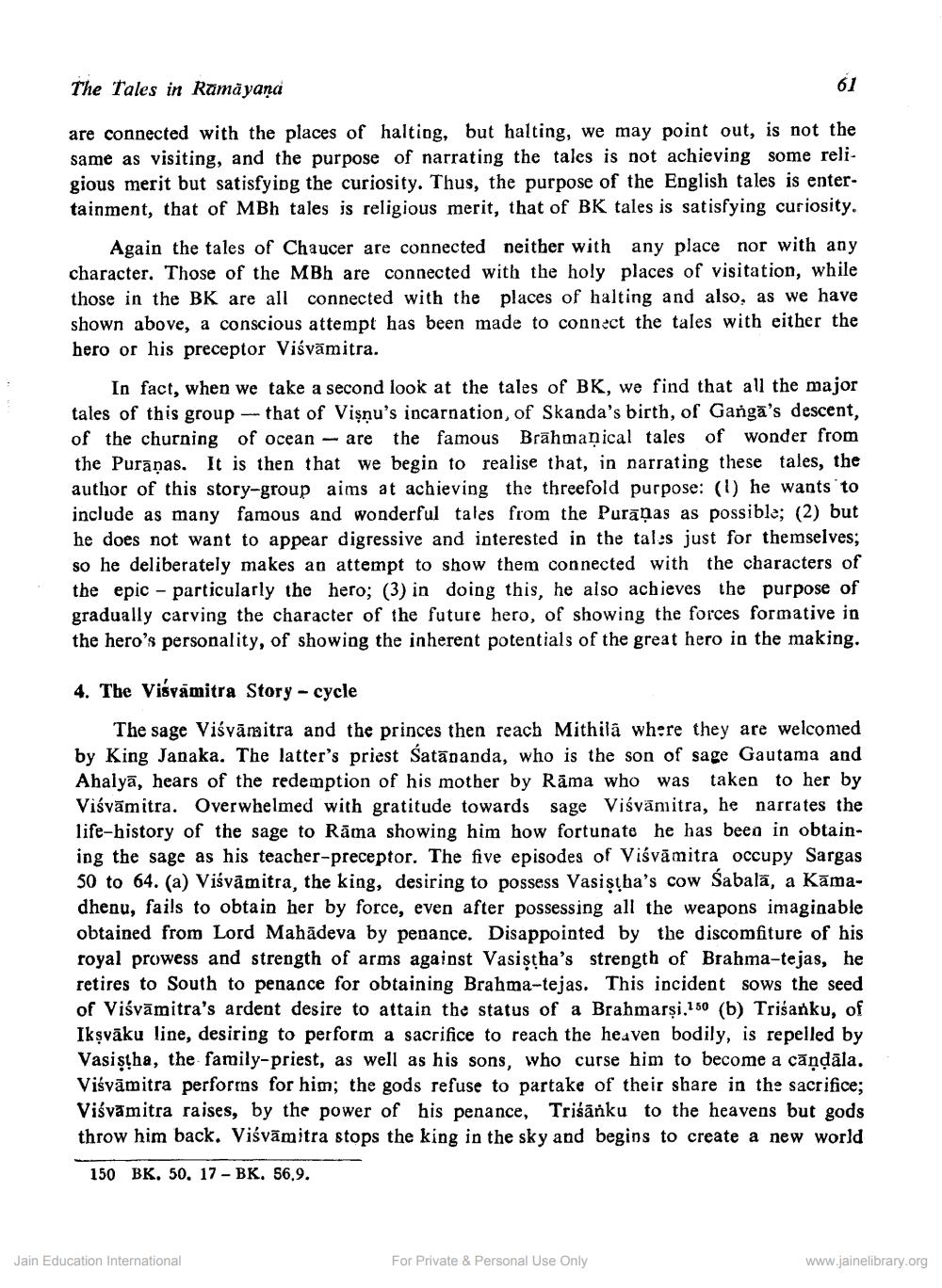________________
The Tales in Ramayana
are connected with the places of halting, but halting, we may point out, is not the
e as visiting, and the purpose of narrating the tales is not achieving some religious merit but satisfying the curiosity. Thus, the purpose of the English tales is entertainment, that of MBh tales is religious merit, that of BK tales is satisfying curiosity.
Again the tales of Chaucer are connected neither with any place nor with any character. Those of the MBh are connected with the holy places of visitation, while those in the BK are all connected with the places of halting and also, as we have shown above, a conscious attempt has been made to connect the tales with either the hero or his preceptor Viśvāmitra.
In fact, when we take a second look at the tales of BK, we find that all the major tales of this group that of Vişnu's incarnation, of Skanda's birth, of Gangā's descent, of the churning of ocean - are the famous Brahmanical tales of wonder from the Purāṇas. It is then that we begin to realise that, in narrating these tales, the author of this story-group aims at achieving the threefold purpose: (1) he wants to include as many famous and wonderful tales from the Purāņas as possible; (2) but he does not want to appear digressive and interested in the tales just for themselves; so he deliberately makes an attempt to show them connected with the characters of the epic - particularly the hero; (3) in doing this, he also achieves the purpose of gradually carving the character of the future hero, of showing the forces formative in the hero's personality, of showing the inherent potentials of the great hero in the making.
4. The Visvamitra Story - cycle
The sage Viśvāmitra and the princes then reach Mithila where they are welcomed by King Janaka. The latter's priest Śatānanda, who is the son of sage Gautama and Ahalyā, hears of the redemption of his mother by Rāma who was taken to her by Viśvāmitra. Overwhelmed with gratitude towards sage Viśvānitra, he narrates the life-history of the sage to Rāma showing him how fortunate he has been in obtaining the sage as his teacher-preceptor. The five episodes of Viśvāmitra occupy Sargas 50 to 64. (a) Viśvāmitra, the king, desiring to possess Vasistha's cow Sabalā, a Kāmadhenu, fails to obtain her by force, even after possessing all the weapons imaginable obtained from Lord Mahādeva by penance. Disappointed by the discomfiture of his royal prowess and strength of arms against Vasistha's strength of Brahma-tejas, he retires to South to penance for obtaining Brahma-tejas. This incident sows the seed of Viśvāmitra's ardent desire to attain the status of a Brahmarşi,150 (6) Trisanku, of Ikşvāku line, desiring to perform a sacrifice to reach the heaven bodily, is repelled by Vasistha, the family-priest, as well as his sons, who curse him to become a candāla. Viśvāmitra perforrns for him; the gods refuse to partake of their share in the sacrifice; Viśvāmitra raises, by the power of his penance, Trišānku to the heavens but gods throw him back. Viśvāmitra stops the king in the sky and begins to create a new world
150
BK, 50, 17 - BK, 56,9.
Jain Education International
For Private & Personal Use Only
www.jainelibrary.org




